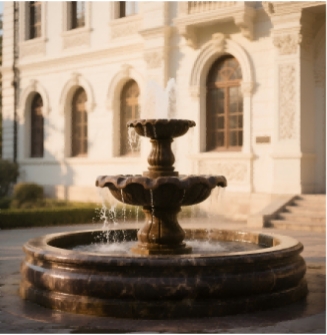Which Stones Are Suitable for Fountains?
2025-07-29
A stone fountain can add timeless elegance and tranquility to any outdoor space. But not all stone materials are created equal. When choosing a fountain, the type of stone you select plays a major role in its durability, appearance, and long-term maintenance. So which stones are best suited for fountains? Let’s explore some of the most popular and practical options.
Granite: Durable and Timeless
Granite is one of the most durable natural stones, making it an excellent choice for outdoor fountains. It can withstand harsh weather conditions, including freezing winters and strong sunlight, without cracking or fading. Granite also offers a wide variety of natural colors and patterns, from deep black to speckled gray or warm earth tones.
One of granite’s biggest advantages is its density. It is highly resistant to water absorption, which helps reduce the risk of moss buildup and surface damage over time. While it can be more expensive than other stones, its longevity often makes it a worthwhile investment.
Marble: Elegant but High Maintenance
Marble is known for its classic beauty and smooth surface. It’s often used for more formal or decorative fountains where aesthetics take center stage. However, marble is softer and more porous than granite, which makes it more prone to staining, scratching, and weathering—especially in outdoor environments.
If you choose marble for your fountain, consider placing it in a covered or partially shaded area. Regular sealing and maintenance will also help preserve its appearance and extend its lifespan.

Limestone: Warm and Natural Look
Limestone offers a soft, natural look that blends well with many garden styles. It’s a relatively soft stone, which makes it easier to carve and shape into artistic forms. Its light beige or cream tones give a warm, inviting feel to outdoor spaces.
However, like marble, limestone is porous and can be sensitive to weather changes. It may not be ideal for areas with heavy rainfall or freezing temperatures unless it is sealed and protected properly. It is best used in milder climates or under shelter.
Sandstone: Textured and Earthy
Sandstone is another popular choice for fountains, especially in rustic or naturalistic garden designs. It has a slightly rough texture and earthy color palette ranging from tan to reddish-brown.
Sandstone is easier to work with and relatively affordable, but it can be prone to erosion or flaking if not sealed. Regular care and cleaning are essential to keep a sandstone fountain looking its best over time.
Slate: Modern and Distinctive
Slate offers a sleek, modern aesthetic with its layered texture and dark, rich tones. It is water-resistant and performs well in various climates, making it suitable for both indoor and outdoor fountains.
Slate works especially well in wall-mounted or cascading water features, where its natural layering adds depth and interest. It may not be as structurally strong as granite, but it holds up well when installed properly and sealed to prevent moisture intrusion.
Basalt: Minimalist and Striking
Basalt is a volcanic rock that has grown in popularity for use in modern, minimalist fountains. Its deep charcoal or black color and smooth finish create a striking look that complements contemporary landscapes.
Basalt is dense, durable, and resistant to water absorption. Columnar basalt is often used to create stunning bubbling fountains or stacked water features. Its naturally geometric shapes and low maintenance make it a top choice for designers seeking simplicity with impact.
Choosing the Right Stone for Your Fountain
The best stone for your fountain depends on your climate, style preferences, and willingness to maintain it. If durability and low maintenance are priorities, granite or basalt are excellent choices. If you’re looking for elegance and artistic detail, marble or limestone may suit your vision better—just be prepared for a bit more upkeep.
Ultimately, a well-chosen stone fountain becomes more than just a water feature. It becomes a focal point, a conversation piece, and a source of calm for years to come.
Thinking of installing a fountain in your backyard or garden? Our team can help you choose the right stone and design to match your space and lifestyle.


